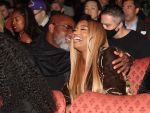Sheldon Mba isn’t feeling the excuses when one of his peers cites a fear of needles for not signing up for the bone marrow registry.
“You’re scared of needles, but you have tattoos and piercings. Really?” says Mba, 19, who is looking for a match to beat aplastic anemia, a disorder in which the bone marrow fails to make enough blood cells.
The Durham, N.C., resident is one of nearly 12,000 Americans who wait each year in hope of a potentially life-saving bone marrow or umbilical cord blood transplant. About 2,500 black Americans are on the waiting list each year.
“We have 10.5 million people on the registry” worldwide, said Nadya Dutchen, a national account executive with Be The Match, an organization that connects patients who have life-threatening blood cancers like leukemia and lymphoma or other diseases with donor matches.
Dutchen said that although Be The Match isn’t “seeing the flood that we would like,” donor registration is up at historically black colleges and universities (HBCUs).
“This year was the largest amount registered, 4,500 during the academic year,” Dutchen said. “On the whole, overall, recruitment was very difficult.”
Part of the problem, she said, was that because of sequestration, government funding, which allowed the organization to blanket more communities with their message, can potentially be cut 10-15 percent, about a $43 million dent in the budget. So recruitment efforts focused on younger donors, who are requested by transplant doctors more frequently.
Anyone, from 18-61, can join the register, but ages 18-44 are considered the optimal donors because “they give patients better outcomes. Survivorship is higher, the incidence of side effects are lower” and this is true even for those who are in exceptionally good health after the age of 45.
“Black doesn’t crack and we don’t look our age, but everything is still aging internally,” Dutchen said.
There are 10.5 million people on the U.S. registration and black people make up about 7 percent of the registry, but because ‘we have such genetic diversity in our culture…our DNA is more complicated and more diverse,” so more black people are needed for the registry.
Only about 30 percent of patients waiting for a match find it within their immediate families: parents, grandparents and full siblings, not half-brothers or sisters.
Mba said no one in his immediate family is a match, so “I have to get on the registry and that’s just difficult.”
The North Carolina Central University student who is studying dance and counseling, said that in February 2012, during his senior year in high school and about a month after losing his father to prostate cancer, he began getting sick with flu-like symptoms and fatigue.
“I was battling this for some time before I got treatment. I was saying ‘I’m just tired,’ or ‘I need to change my diet.’”
Soon, though, Mba could no longer ignore the problem.
“I was on my way to a performing arts ceremony, went upstairs to show my mom how I looked and I collapsed; and my mom said, ‘Okay, you’re going to the hospital.’”
Getting a handle on the problem early is key to a good outcome, says Dr. Jeffrey Chell, CEO of the National Marrow Donor Program and Be The Match.
“Earlier diagnosis and treatment, better managing, better medications to treat infections and other complications. More belief that transplant works, so there’s a tendency to transplant earlier in the disease rather than late in the disease when outcomes aren’t as good,” Chell told the Twin Cities Business Journal.
Under Chell’s leardership, the Be The Match registry more than doubled to 10.5 million and the number of transplants facilitated has tripled to more than 5,800 annually.
“We want to become a household name among our donors and around people who would be willing to contribute financially to helping drive research or add more people to the registry or cover some of the costs that insurance doesn’t cover,” Chell said.
During July, African American Bone Marrow Awareness Month, Be The Match is encouraging African Americans to join the registry as potential marrow donors or make a donation.
Dutchen said the goal is also to get rid of some of the myths that have discouraged black folks from registering.
It only takes a cheek swab to register. If you are called to donate it is not an extremely invasive procedure. In most cases, you donate plasma and platelets, under a local anesthetic, in a one-day, outpatient procedure. Actual marrow donation also is an outpatient procedure, in which doctors use a needle to withdraw liquid marrow from the back of your pelvic bone. The marrow replaces itself completely within 4 to 6 weeks. Donors feel some soreness, but no major pain.
The No. 1 myth, Dutchen said, is that donating is extremely painful.
“No. No. No. No. It’s not. No. 1, it’s not; and No. 2, it’s not true, but people believe what they hear….the discomfort is not that much compared to the pain the patients are going through.”
Potential donors can visit Be The Match, It’s on You, a special site that addresses the importance of transplants for African American patients. The site also provides information for those who wish to donate money or host a marrow registry drive.
Meanwhile, Sheldon Mba, hosts blood drives at HBCUs, including North Carolina Central, while he ways for a match and takes seven pills a day to hold his illness at bay.
It could be worse, he notes, “My mother said, ‘You want to be on this side or the other side?’”
Click here for answers to your “Get Well Wednesday” questions.

















